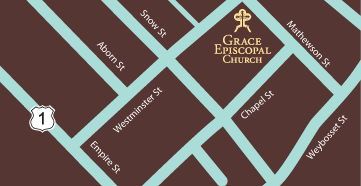Tour our Windows
The Windows of Grace Episcopal Church
The interior of Grace Church 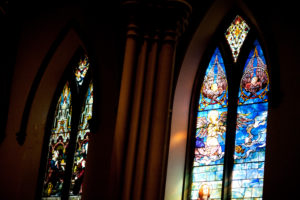 is a profoundly moving and evocative place. The ethereal space of the nave is at once soaring and intimate; even as the vaulted ceiling lifts away from the eye, the space below – anchored by the solid, sweeping forms of the columns and lit by the warm glow of the pews – is embracing, warm and entirely human.
is a profoundly moving and evocative place. The ethereal space of the nave is at once soaring and intimate; even as the vaulted ceiling lifts away from the eye, the space below – anchored by the solid, sweeping forms of the columns and lit by the warm glow of the pews – is embracing, warm and entirely human.
This space is beautiful in its own right. But it is particularly enriched by the brilliant glass adorning every wall: Grace’s magnificent windows. They pour their clear, saturated colors into the space, and infuse every wall with life. They are also a true historical treasure – with deep personal and spiritual significance – and they reflect some of the greatest creative effort from some of the finest artists of the time.
During daylight hours, nearly a century’s worth of art (1846-1929) is dramatically displayed in more than 15 windows. Individually, they are works of art; viewed collectively, the windows form a lasting legacy of the people who were an integral part of Grace Church’s earliest years.
Each window is a unique memorial, with its own story to tell. The content that follows is your guide for a walk through those stories.
The Narthex
Our walk begins in the narthex, or entrance 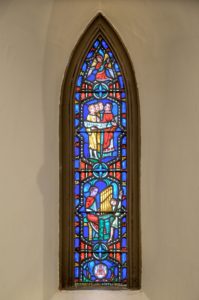 hall, of Grace Church. The narthex features a pair of brilliant, deep-set windows, both dedicated in 1949, that memorialize Richard William Whipple and Ashbel Tingley Wall. Whipple (1925-1945) was a chorister at Grace, and the choir’s symbol can be seen above the dedication. Wall was a vestry member, and members of his family still continue his tradition of service to the church. The Grace Church seal is included in this window.
hall, of Grace Church. The narthex features a pair of brilliant, deep-set windows, both dedicated in 1949, that memorialize Richard William Whipple and Ashbel Tingley Wall. Whipple (1925-1945) was a chorister at Grace, and the choir’s symbol can be seen above the dedication. Wall was a vestry member, and members of his family still continue his tradition of service to the church. The Grace Church seal is included in this window.
A third window, now located in a recently installed restroom, features St. Augustine. It was given by Flora Henius in 1950, in memory of her brother Arthur, who was known to be an admirer of the great saint.
Next walk through the doors in the arch, and into the nave of the church, where the windows continue the illustrated story of Grace Church’s history and the faith of its parishioners. As you enter the nave, turn left to find the first window on the tour. Then move down the east aisle toward the front of the church.
The Nave
1. Dedicated to Mary Earle Carlisle, 1891.
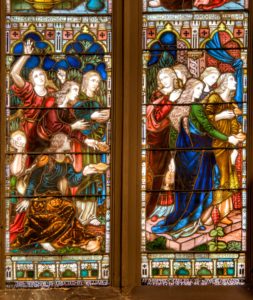 The first window in the east aisle of the church was given by the parents of Mary Earle Carlisle, who was only 21 when she died, in their daughter’s memory. Fittingly, this antique-style window* illustrates two Biblical scenes featuring young women. The bottom scene depicts the parable of the wise and foolish virgins (Matthew 25:1-13). The five wise virgins, on the right, are well-prepared and have brought enough oil to light their lamps, while the five foolish virgins, on the left, have run out of oil. The inscription from Matthew reminds us to always be ready for Jesus’ coming.
The first window in the east aisle of the church was given by the parents of Mary Earle Carlisle, who was only 21 when she died, in their daughter’s memory. Fittingly, this antique-style window* illustrates two Biblical scenes featuring young women. The bottom scene depicts the parable of the wise and foolish virgins (Matthew 25:1-13). The five wise virgins, on the right, are well-prepared and have brought enough oil to light their lamps, while the five foolish virgins, on the left, have run out of oil. The inscription from Matthew reminds us to always be ready for Jesus’ coming.
The top scene portrays the story of Jesus’ visit to the house of two sisters, Martha and Mary (Luke 10:38-42). On the left, Jesus is identified by his cross-shaped halo. On the right, Martha serves Jesus while Mary sits listening to his teachings. The quotation is part of Jesus’ reply to Martha, who complained that her sister had left her to do all the serving by herself: “Martha, thou art … troubled about many things. But one thing is needful, and Mary hath chosen that good part.” (This story is also depicted in window 13.) Note the beautiful, small archways at the base. Like many of the windows, this one contains very accurate images of plants and flowers – almost botanical illustrations in their own right.
*typical art style of stained glass in the period from 1900 to 1930; each artist had his or her own style
2. Dedicated to Byron Smith, 1888.
Harriet Almira Sherman Barnaby donated the second window on the east aisle. Harriet, the widow of Byron Smith, also was the sister of Jerothmul Bowers Barnaby to whom window 10 is dedicated. Byron Smith was a Providence druggist who died at age 49 in France, where he had hoped to regain his health.
A single, tranquil scene fills this opalescent-style window**. This is an image of the vision of St. John of Patmos, the author of the Book of Revelation. The New York Times of March 29, 1888, described it as “… exceedingly beautiful … from an artistic point of view, the work is excellent.”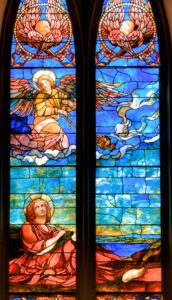
St. John reclines in the foreground with a book on his knee, in which he is writing at the inspiration of the angel above him. A lovely bay lies beyond his feet, and beyond is the further shore. The angel swings a thurible (incense burner), the smoke drifting across the sky. The Times article notes that “a hundred square feet of colored glass were used in the construction, and the only portions in which any painting was done were the figures of St. John and the angel.”
** Opalescent glass was created by Louis Comfort Tiffany in his Brooklyn (N.Y.) studio. Once he started using it, everyone else copied it and it soon became available from many sources. Opalescent glass has the color somewhat “streaked” and is colored glass, not glass that has been painted.
3. Dedicated to Francis Edwin Hoppin and his four sons, Thomas Coles Hoppin, Francis Hoppin, Henry Anthony Hoppin and Frederick Huntington Hoppin, 1886.
The next window on the east side was, indeed, designed by Tiffany Studios of New York and has much in common with the previous one. The elaborate scroll at the bottom tells us that the window is for Francis Edwin Hoppin and four of his sons – all of whom died in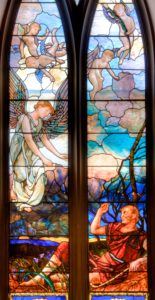 infancy. Hoppin was a prosperous lawyer and vestry member of Grace Church. At the age of 39, he was stricken with a debilitating disease from which he died 10 years later.
infancy. Hoppin was a prosperous lawyer and vestry member of Grace Church. At the age of 39, he was stricken with a debilitating disease from which he died 10 years later.
Both the previous window and this one use the opalescent technique to illustrate a single scene that may portray the man for whom the window was made. Here we also have a reclining man in an outdoor setting. He seems to be waking from sleep, which may symbolize the entrance into a new life after death. The lower portion of the scene, which is in dark, somber colors, contrasts greatly with the pale, ethereal tones of the upper portion. There, an angel greets the man, ready to take him to the celestial palace, which is shown as a dome in the clouds at the top of the window. Also featured are four flying cherubs, which may represent the souls of Smith’s four infant sons, who greet their father in the afterlife.
4. Dedicated to Walter Paine and Sophie Field Paine, 1885.
Like the previous windows, family members donated this window in memory of their loved ones – in this case, adult children memorializing their parents. Walter and Sophie Paine married in 1823 and lived for many years on Mathewson Street, worshiping 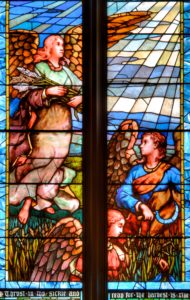 together at Grace Church for half a century. Walter was active in city affairs and held many public offices, while Sophie was known for her devotion to her large family.
together at Grace Church for half a century. Walter was active in city affairs and held many public offices, while Sophie was known for her devotion to her large family.
The single scene, done in the opalescent style, illustrates a passage from Revelation (Rev 14:15), which concerns preparation for the judgment day: “Thrust in thy sickle and reap for the harvest is ripe.” Three angels, in the foreground, are busy with the harvest, reaping and gathering grain into sheaves. Behind them, an expanse of cultivated fields recedes into the distance, while at the very top a dove gazes down upon the activity. Of note are the round blue and green gem-like glass pieces, and the handsome, nearly trompe l’oeil effect of the stone blocks in the bottom panes.
5. Dedicated to Amasa Manton and his wife Eliza Taylor Manton, 1846, 1882.
This antique-style window is one of the oldest stained glass windows in the country, even perhaps older than those in Trinity Church in New York City and Christ Church in Brooklyn, N.Y., both designed around the same time by Richard Upjohn, the architect of Grace Church. It is unique in that it is the only one not created especially for its current location. Amasa (1795-1869) and Eliza Manton (d.1873) were generous contributors to their community, giving money to many small Rhode Island towns to start public libraries and helping to build and furnish Grace Church. In 1846, they provided the original chancel window for the church, which was then composed of two smaller windows flanking a larger one. In 1882, when the chancel was altered and a new memorial window erected there, the largest of the original windows was given to a mission and the two smaller ones were placed together in their present location, with the addition of a medallion at the top, as a memorial to the Mantons.
Rather than depicting a scene, the window is a collection of various religious emblems. On the left, beginning at the bottom, is an anchor on a white shield, the traditional symbol of hope and the seal of the state of Rhode Island. Above that is a cross surrounded by the letters INRI, representing the inscription placed above the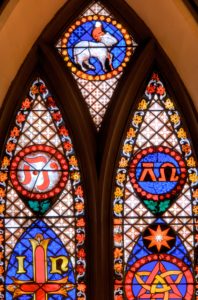 crucified Christ (initials in Latin for “Jesus of Nazareth, King of the Jews”).
crucified Christ (initials in Latin for “Jesus of Nazareth, King of the Jews”).
The symbol at top left is an abbreviation of the Tetragrammaton Y(a)H, used in the Hebrew Bible to refer to the name of the God of Israel. On the right, bottom, is a stylized monogram of the first two letters of Christ in Greek, Chi Rho. Above that is the symbol of the Trinity, a triangle interlaced with circular arcs, surrounded by a circle. At top right are the letters alpha and omega, the first and last letters of the Greek alphabet, representing the eternity of God. The central medallion at the very top shows a lamb carrying a red triumphal banner, an image symbolizing the resurrection whereby Jesus, the Lamb of God, triumphs over death and sin. In the bottom panels are very beautiful images of Passiflora, or passion flowers, which are believed to represent the crucifixion.
6. Dedicated to Harriet Dunn Hoppin, 1875.
Harriet Dunn Hoppin, 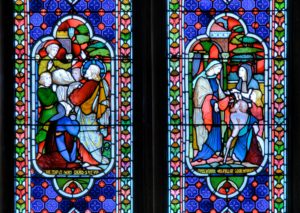 daughter of Governor William and Anne (Dunn) Jones, married Thomas Coles Hoppin in 1811 and raised 12 children, three of whom became vestry members at Grace Church. The virtues of faith and charity are the themes of this antique-style window, which was given by Mrs. Hoppin’s children, grandchildren and great-grandchildren. We may assume they selected these particular themes to honor those same qualities possessed by their family matriarch.
daughter of Governor William and Anne (Dunn) Jones, married Thomas Coles Hoppin in 1811 and raised 12 children, three of whom became vestry members at Grace Church. The virtues of faith and charity are the themes of this antique-style window, which was given by Mrs. Hoppin’s children, grandchildren and great-grandchildren. We may assume they selected these particular themes to honor those same qualities possessed by their family matriarch.
Charity is personified at the upper left, as a woman cradling one child while tenderly stroking another’s hair. The personification of faith, on the right, holds a Bible and staff while wearing a crown of white flowers, which symbolize purity. Below these figures are scenes depicting specific acts of faith and charity. On the left, the power of faith is dramatized in a scene of Jesus raising someone from the dead, with the inscription: “He that was dead sat up” (Luke 7:15). On the right, an example of charity is shown by a woman giving alms to the poor and disabled. The accompanying inscription is from Acts 9:36: “This woman was full of good works.”
7. Dedicated to Shepard Carey Kinsley, circa 1884.
This final window on the east aisle, dedicated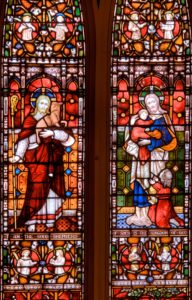 to a longtime teacher and superintendent of Grace Church’s Sunday School, is appropriately filled with imagery and themes relating to children. Donated by the Sunday School, the antique-style window portrays Jesus in four separate scenes, each accompanied by a Biblical inscription. First, at lower right, is the traditional nativity scene, with the Christ Child surrounded by Mary and Joseph, adoring angels and barn animals. Above that is the adult Jesus, the good shepherd, shown holding a lamb. The scene beside this shows Jesus with two children; he holds one in his arms and kindly gazes at the other child, who also wants to be held. In the last scene, Jesus instructs his disciples to be like the little child whom he has called to stand before them: “Therefore whoever humbles himself as this little child is the greatest in the kingdom of heaven.” (Matthew 18:4)
to a longtime teacher and superintendent of Grace Church’s Sunday School, is appropriately filled with imagery and themes relating to children. Donated by the Sunday School, the antique-style window portrays Jesus in four separate scenes, each accompanied by a Biblical inscription. First, at lower right, is the traditional nativity scene, with the Christ Child surrounded by Mary and Joseph, adoring angels and barn animals. Above that is the adult Jesus, the good shepherd, shown holding a lamb. The scene beside this shows Jesus with two children; he holds one in his arms and kindly gazes at the other child, who also wants to be held. In the last scene, Jesus instructs his disciples to be like the little child whom he has called to stand before them: “Therefore whoever humbles himself as this little child is the greatest in the kingdom of heaven.” (Matthew 18:4)
Now turn right and start across the nave to the west aisle. When you come to the center aisle, stop and look to the left into the chancel.
The Chancel
Created in 1882 and modified in 1912 when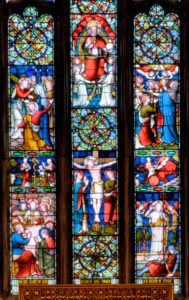 the new chancel was built, the antique-style window honors three of the early rectors of Grace Church: the Rev. John A. Clark, the Rev. Alexander Vinton, and the Rt. Rev. John P.K. Henshaw (also Bishop of Rhode Island). New figure groups, tracery and geometric medallions were incorporated by architects Cram, Goodhue & Ferguson into the original window design.
the new chancel was built, the antique-style window honors three of the early rectors of Grace Church: the Rev. John A. Clark, the Rev. Alexander Vinton, and the Rt. Rev. John P.K. Henshaw (also Bishop of Rhode Island). New figure groups, tracery and geometric medallions were incorporated by architects Cram, Goodhue & Ferguson into the original window design.
The crucified Christ is shown in the chancel widow’s large central panel. On either side are two Old Testament scenes: Moses lifting the serpent on the left, and Elijah driving the fiery chariot on the right. The remaining scenes, taken from the New Testament, depict various events in the life, death, and resurrection of Christ. The top panel shows Christ, enthroned in glory, as both God and man. His mantle is fastened with an elaborate brooch, possibly modeled after one found in the 15th century Ghent Altarpiece of Hubert and Jan Van Eyck in Belgium.
The chancel altar itself memorializes the life of Eliza Harris Hoppin (1821-1891), widow of Francis Edwin Hoppin (subject of window 3). The altar was given in 1912 by Eliza and Francis’ son and three daughters. In 1929, the original painted triptych was replaced by carved oak panels created by Ernest Pelligrini of Boston. These were presented to the church by the Hoppins’ youngest daughter, Eliza Anthony Hoppin Gammell. The angel windows were given by Virginia Gammell Cross, granddaughter of Eliza Harris Hoppin.
Continue your tour by proceeding to the windows along the west aisle.
8. Dedicated to Malachi R. and Harriet Brownell Gardiner, and Edwin R. and Abbie S. Gardiner, 1905.
The theme of family, found so frequently in Grace Church’s windows, is continued in this antique-style window that begins your tour of the west aisle.
Malachi R. Gardiner married Harriet Brownell in 1831. An accountant, he was elected Secretary of the Corporation of Grace in 1834 and later became a vestry member and Sunday School teacher. The couple’s only son, Edwin, was a court reporter who married Abbie Sanford in 1870. Edwin and Abbie had one daughter, Edna Rhodes Gardiner, who erected the window in honor of her parents and paternal grandparents.
Dedicated on Easter Day in 1905, the window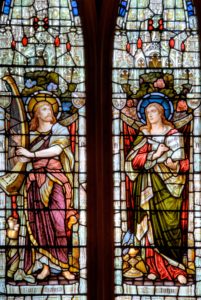 features two portrayals of King David on the left and two portrayals of St. John on the right. At top left, a young David plays his harp, while below, a much older King David is shown with his son Solomon. The inscription, “David’s charge to Solomon,” refers to when God tells David that the holy temple he wishes to build should instead be built by Solomon. As described in the Bible (I Chronicles 28), the scene depicts an aged King David giving his son the plans for the temple, while workers in the background begin its construction.
features two portrayals of King David on the left and two portrayals of St. John on the right. At top left, a young David plays his harp, while below, a much older King David is shown with his son Solomon. The inscription, “David’s charge to Solomon,” refers to when God tells David that the holy temple he wishes to build should instead be built by Solomon. As described in the Bible (I Chronicles 28), the scene depicts an aged King David giving his son the plans for the temple, while workers in the background begin its construction.
The same progression from youth to age is shown in the right half of the window. At the top, a young St. John writes his gospel, while below, an aged St. John writes his book of visions, Revelation. Befittingly, an angel visits St. John and shows him a vision of another angel, to whom the old saint lifts his eyes. An interesting decorative touch is found in the green blocks at the bottom of the window, whose alternating pattern contains, at left, the monogram “KD” for King David and, at right, “SJ” for St. John.
Now continue toward the rear of the church to view the remaining windows.
9. Dedicated to Howard H. Arnold and Madeline T. Arnold, 1891.
This poignant opalescent-style window was given by James B. and Ellen M. 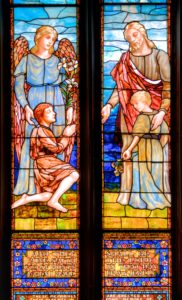 Arnold in remembrance of their son, who died at age 15, and their daughter, who died at age 9. James and Ellen were active members of Grace Church; in fact, Ellen belonged to the Missionary Society. James’ profession was gold and silver refining, and given that family business and the children’s early deaths, the window’s Biblical inscription, with its metaphor of jewels, seems especially meaningful. The inscription (from Malachi 3:17) tells of a group of people who were devoted to God. The Lord heard these people, and a book of remembrance was written for him so that, “in that day when I make up my jewels,” God would remember the righteous ones and make them his own. The scene illustrates how these “jewels of God” – in this case the two children – are brought by an angel to meet Jesus, who draws the little girl close to him, and extends his other hand to the little genuflecting boy. The angel holds lilies, symbols of purity.
Arnold in remembrance of their son, who died at age 15, and their daughter, who died at age 9. James and Ellen were active members of Grace Church; in fact, Ellen belonged to the Missionary Society. James’ profession was gold and silver refining, and given that family business and the children’s early deaths, the window’s Biblical inscription, with its metaphor of jewels, seems especially meaningful. The inscription (from Malachi 3:17) tells of a group of people who were devoted to God. The Lord heard these people, and a book of remembrance was written for him so that, “in that day when I make up my jewels,” God would remember the righteous ones and make them his own. The scene illustrates how these “jewels of God” – in this case the two children – are brought by an angel to meet Jesus, who draws the little girl close to him, and extends his other hand to the little genuflecting boy. The angel holds lilies, symbols of purity.
10. Dedicated to Jerothmul Bowers Barnaby, 1891.
This next window is unusual in that its dedication is not in the glass but is found on a plaque below the window. It reads: “To the Glory of God and in Loving Memory of Jerothmul Bowers Barnaby. Born October 27, 1830. Died September 19, 1888.”
Jerothmul, brother of the window’s donor, Harriet Barnaby, was a direct descendent of James Barnaby of Plymouth, Mass., and husband of Lydia Bartlett, granddaughter of Richard Warren, who traveled to America on the Mayflower. Jerothmul and his wife had three children and were regular worshippers and generous contributors to Grace. In addition to operating a clothing store in Providence, Jerothmul served on the City Council and was once a Democratic candidate for Governor of Rhode Island.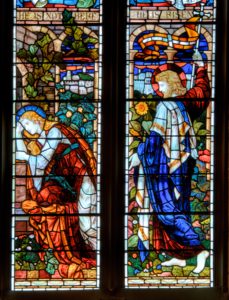
The primary scene of this window depicts the suspenseful moment before the Risen Christ reveals himself to Mary Magdalene. At left, a despondent Mary leans on the empty tomb, believing someone has taken away Jesus’ body. Above the scene is a pair of angels, representing the two angels Mary saw in the tomb where the body of Christ should have been. As described in the gospel of John, Jesus comes up behind Mary as she is crying. Turning around, Mary does not recognize him at first, until he speaks her name, and she realizes he has indeed been resurrected. Here he strides toward her past sunflowers, symbolizing adoration, and red poppies, representing consolation.
11. Dedicated to Maria Louise Prentice, 1891.
This antique-style window is one of the most personalized of the Grace Church windows. Maria Louise Prentice was an ardent Episcopalian and member of Grace; her husband, George W. Prentice, was a vestry member. The couple had no children.
The main image is a woman in a colorful garden. The woman not only represents Maria Prentice, but her face was actually copied from a photograph of Maria to create the likeness. The hollyhocks were reproduced from a painting of hollyhocks that 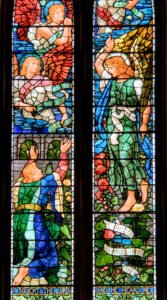 Maria herself had done.
Maria herself had done.
Below the scene is the inscription “I sought the Lord and He heard me” (Psalm 34). We know the Lord has heard this woman’s call, for an angel, God’s messenger, appears to her. The angel points up to a beautiful paradise full of angels in flight, their dramatic, sculptural wings beautifully rendered and full of motion. The inscription under the angel tells us that the woman is now protected by the angels: “He shall give his angels charge over thee” (Psalm 91).
The angel theme is continued in a scroll that wraps around the six other angels. Although obscured in parts, the scroll bears a verse that explains the purpose of angels: “Are they not all ministering spirits, sent forth to minister for them who shall be heirs of salvation?” (Hebrews 1:14)
12. Dedicated to William T. Nicholson Jr., 1891.
As in other windows in Grace Church, this one memorializes a family member lost prematurely. William T. Nicholson Jr. was the third son of William Thomas and Elizabeth Dexter Gardiner Nicholson. He attended Brown University and was prominent in athletic and musical organizations. An usher at Grace Church, William was appointed a member of the 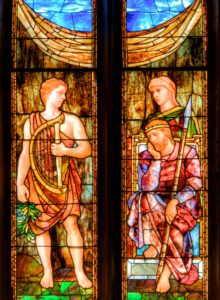 Governor’s staff after his graduation from college. He was engaged to be married when he died, at age 25, from typhoid fever. The window was erected by his father.
Governor’s staff after his graduation from college. He was engaged to be married when he died, at age 25, from typhoid fever. The window was erected by his father.
The main subject in the scene is David, who plays a harp for Saul as the older man rests on his throne. The face of David is modeled after William himself and, as in the previous window, it was copied from a photograph, to recreate his features in the window. The harp and the scroll of musical notes above the inscription clearly refer to William’s love of music. The traditional religious theme – the beauty and strength of David – is rendered deeply personal by these details and by the fact that the window is a memorial from a grieving father who thought his son worthy of the association with this important Biblical figure.
13. Dedicated to Hildegard von Brockdorff, 1921.
This antique-style window, honoring a woman who devoted her life to the church, commemorates Biblical women who were famous for their good deeds. Hildegard von Brockdorff was the daughter of a Danish nobleman and a prominent English woman. Her parents immigrated to Canada, where she was born in 1859. Hildegard spent years at several churches in New York City and at Grace Church, where she was a deaconess. Members of Grace Church raised funds for this window, which was dedicated on Christmas morning in 1921.
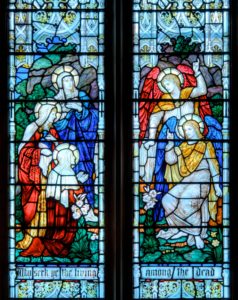 The window’s scenes depict scenarios also seen in other windows here. The two upper panels, as in window 10, show Christ’s tomb after the Resurrection. Here, three women – Mary Magdalene, Joanna and Mary the mother of Jesus – visit Christ’s empty tomb (from Luke 24), where, as in the Gospel of John, two angels appear.
The window’s scenes depict scenarios also seen in other windows here. The two upper panels, as in window 10, show Christ’s tomb after the Resurrection. Here, three women – Mary Magdalene, Joanna and Mary the mother of Jesus – visit Christ’s empty tomb (from Luke 24), where, as in the Gospel of John, two angels appear.
Two scenes appear in the lower windows. At left is a portrayal of Jesus visiting Martha and Mary, also seen in window 1, with the same Biblical inscription. Martha, in blue, stands and serves, while long-haired Mary sits on the floor. The lower-right scene is not portrayed in any other window at Grace. Here, the inscription from Acts seen earlier in window 6 describes a disciple named Tabitha, also known as Dorcas, who was “Full of good works and almsdeeds.” Here, this charitable woman is shown with a halo, giving bread to a poor mother and her two children.
14. Dedicated to Emma Pugh Harden, 1929.
The newest of Grace Church’s windows, and among its most colorful, this was erected by two sons in honor of their mother, who died at age 80. Antique in style, it depicts three scenes from the life of Jesus.
At lower left, the baby Jesus 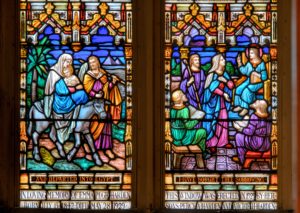 and his parents are shown fleeing into Egypt (note the pyramids in the background) to escape King Herod, who had planned to kill the child. The lower right shows a scene in which the 12-year-old Jesus becomes separated from his parents in Jerusalem (Luke 2:41-51). A worried Mary and Joseph search for their young son – only to find him instructing elders at the temple. The inscription comes from Mary’s words to Jesus when he finally is located – a timeless, universal phrase that is uttered to this day: “Thy father and I have sought thee sorrowing.”
and his parents are shown fleeing into Egypt (note the pyramids in the background) to escape King Herod, who had planned to kill the child. The lower right shows a scene in which the 12-year-old Jesus becomes separated from his parents in Jerusalem (Luke 2:41-51). A worried Mary and Joseph search for their young son – only to find him instructing elders at the temple. The inscription comes from Mary’s words to Jesus when he finally is located – a timeless, universal phrase that is uttered to this day: “Thy father and I have sought thee sorrowing.”
The largest scene takes up the entire top portion of the window. Here the adult Jesus, shown with cross-shaped halo, heals a sick woman who lies in bed. The comforting inscription reads: “And when the Lord saw her, He had compassion on her.”
A Quick History about Grace:
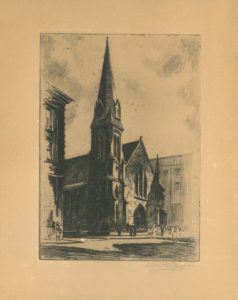 The Grace Church congregation was gathered in 1829, and in 1830 the parish moved to the Providence Theatre (later known as the Albee Theatre). On this site, where the church now sits, Russell Warren, parishioner and senior architect of the historic Westminster Arcade in Providence, redesigned the theatre for use as a church. The new building was consecrated in 1832.
The Grace Church congregation was gathered in 1829, and in 1830 the parish moved to the Providence Theatre (later known as the Albee Theatre). On this site, where the church now sits, Russell Warren, parishioner and senior architect of the historic Westminster Arcade in Providence, redesigned the theatre for use as a church. The new building was consecrated in 1832.
In 1842, under the Rt. Rev. John P.K. Henshaw, who also served as bishop of the new Episcopal Diocese of Rhode Island, the vestry commissioned the foremost architect of the time, Richard Upjohn, to design a beautiful new building. The first asymmetrical Gothic Revival Church in America was completed in 1846.
Trinity Church on Wall Street in New York City, also designed by Upjohn, was built simultaneously, reaching consecration a month before Grace.
In 1912, the parish chose Ralph Adams Cram, another renowned architect, to extend the church’s chancel and to add several stories to the parish house facilities. Cram & Ferguson’s Gothic work includes the main portion of St. John the Divine Cathedral in New York City, the Sterling Library at Yale University and the chapels at both the U.S. Military Academy at West Point and Princeton University. Upjohn and Cram are both honored by the Episcopal Church with a feast day on December 16.


